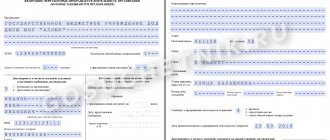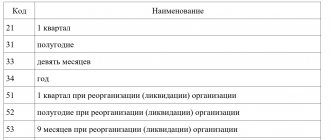What is a list of cases
The nomenclature of an organization’s files is a special list of files (forms, forms, personnel documentation) created in an institution in the course of its activities, compiled according to a certain structure, which indicates the storage period for documentation.
This issue is regulated in Law No. 125-FZ of October 22, 2004 and the basic rules for the work of state archives (02/06/2002). In simple terms, the nomenclature of affairs is a systematic inventory of documentation (reports, orders, time sheets, extracts, certificates and other papers) that are generated in the activities of the organization. Note that the organizational and legal form, type of activity and structure of the institution directly affect the composition of the necessary documentation. A current sample of the list of cases for 2020 with new storage periods is given at the very end of the article. It can be downloaded for free and without registration.
Let's define it with an example. Let’s say that the range of affairs of an educational organization, be it a secondary school, kindergarten or university, will differ significantly from a similar form of a bank or other company.
When developing a list of cases, you should be guided by:
- Regulations on the creation of the organization or the Charter.
- Regulations on all structural divisions of the subject.
- Staffing schedule for the current year.
- Nomenclature of cases from previous years.
- Inventory of files of permanent or temporary storage (more than 10 years).
- Registration forms of the institution.
- Standard and departmental lists of papers indicating storage periods.
- What are the typical and approximate storage periods for documents according to the nomenclature of cases, communicated by higher ministries and departments.
Responsibility for using nomenclature
Organizations that transfer documents to the state archive are required to compile a list of files (clause 2 of Article 20 of the Law “On Archival Affairs in the Russian Federation” dated October 22, 2004 No. 125-FZ, introductory part of the Basic Rules for the Operation of Archives of Organizations, approved by the decision of the Rosarkhiv Board of February 6, 2002 ):
- state and municipal;
- non-state in terms of documents classified as state property;
- non-state, if they have concluded an agreement with the state archive.
Other legal entities have no obligation to draw up nomenclature. But it should be borne in mind that in the event of liquidation of a non-governmental organization, its documents are submitted to the state archive (Clause 10, Article 23 of Law No. 125-FZ), and in this case a list of files will be needed.
In addition, non-governmental organizations must store archival documents for the established storage periods (Clause 1, Article 17 of Law No. 125-FZ), i.e., create their own archives. It is more convenient to create such an archive according to the current rules approved by Rosarkhiv. Having a list of cases drawn up according to these rules will not only help a legal entity in recording documents, working with them, storing and destroying them, but will also facilitate the transfer of cases to another organization in the event of reorganization or to the state archive in case of liquidation.
How to liquidate an organization, read our articles:
- “Liquidation of a joint stock company - step-by-step instructions”;
- “The procedure for closing an LLC - step-by-step instructions.”
Read about drawing up a liquidation balance sheet in the article “Liquidation balance sheet - an example of a zero balance sheet according to the new form.”
Sphere of purpose
The key purpose of the nomenclature of files is to systematize document flow within one subject - an institution. That is, the direct purpose of the nomenclature is to group all documentation to facilitate accounting, search, storage of papers, certificates, etc.
The need for the document is due to the solution of the following tasks:
- simplification of classification, accounting and organization of storage of business and personnel documentation;
- reducing the time spent searching for the required form or file in general office work;
- facilitating the process of transferring cases, compiling inventories of forms;
- ensuring a systematic approach to the preservation and destruction of documentation.
Please note that approval of the sample (nomenclature of organization affairs 2020) is mandatory for all state and municipal institutions. In addition to public sector organizations, all companies that submit documentation to state archives are required to maintain nomenclature. For example, non-state firms in terms of reporting and office work on exploited state property.
Procedure and requirements for registration
The sections of the nomenclature are the names of individual structural divisions of the company , which are placed sequentially, according to the degree of importance for the enterprise. First, the more significant departments of production are indicated, then secondary bodies come and are assigned number indices.
In other cases, sections of the nomenclature may consist of important management positions of the organization , also listed in numerical order (1. general director, 2. deputy director, etc.)
The section is based on the most significant documents and orders from the point of view of the organization’s work. After them, secondary information documentation is attached, such as certificates and correspondence.
Competent filing of a case allows you to successfully and timely find the necessary documents, guarantees their availability and safety, and also significantly streamlines the document flow process itself, which is important in office work, where a lot of documentation usually takes place and is implemented.
Cases are processed at the place of registered documentation - in the office or in the secretariat. This procedure is carried out in accordance with the names of cases according to the pre-formed nomenclature of the organization or according to classification indicators.
In the bulk of enterprises, the creation of cases is carried out according to the names of the types of documents (acts, decrees, contracts, etc.)
When creating cases, you must adhere to the following conditions:
- Only completed and correctly executed documentation is placed in the files.
- Documentation that addresses issues that fall under the general section is placed in the general file.
- One file contains only one sample document (original or certified copy).
- Any document entered into the file must be correctly executed (dated, signed, stamped, etc.) in accordance with Federal standards.
- To provide additional convenience for working with nomenclature, documentation from the same year of registration is primarily integrated into the same file.
- The documentation is actually placed in chronological order (03/02/2006, 03/03/2006, etc.), in numerological order (No. 1, No. 2..) or in alphabetical order (by the names of the creators of the documents, or in alphabetical order by the names of institutions - correspondents).
- A time-logical concept is often used, in which documentation is placed in files in the process of solving certain problems. This system of document placement is essentially similar to the chronological one.
- Documentation of different storage periods is distributed into different files.
- Documents that do not correspond to its name, are incorrectly compiled (sent for revision), are not drafted, or are printed on a copier cannot be placed in the file.
- The case cannot include more than 250 sheets, and for this reason, if there are more papers, they will be transferred in several volumes, indicating the volume number on the front side.
- An organization's contracts can be divided into two categories and kept in different files. In one category there are trade agreements among commercial organizations, in the other - working agreements (contracts) with employees.
- Decrees on labor activities are issued separately from decrees to employees of the organization.
- Documents reflecting the labor relationship between the employee and the employer are drawn up in alphabetical order by the last names of the employees.
When creating cases with correspondence, the main condition is its size .
If the size of the correspondence is not very significant, then a single file is drawn up, which includes absolutely all incoming and outgoing messages, letters, calls, e-mails, etc.
Assuming an increase in the volume of correspondence with business partners, a rational solution would be to purchase a separate file for all business correspondence. With a subsequent increase in the size of correspondence, you can also divide incoming and outgoing correspondence according to their types: paper correspondence, e-mail, etc.
Projects and reports are stored in the files of the year to which they belong according to its information content , regardless of the period of their formation or registration.
On the front you must indicate:
- name of company;
- index number and volume number when the case is divided into a number of houses;
- title of the case;
- year of registration;
- number of sheets;
- storage time.
Types of nomenclature
There are currently three types of case nomenclature:
- Standard is a type of file nomenclature (ND), which determines the list of documentation and files for similar organizations.
- The approximate nomenclature of cases reflects the approximate composition of cases and their indexes for the institutions to which these lists apply.
- Individual is a type of nomenclature of cases that is approved in a specific institution on the basis of standard and exemplary nomenclature administrative orders.
It is worth noting that standard and approximate inventory forms are usually enshrined in the regulations of higher ministries and departments. The norms apply to all subordinate institutions and structural units. Such a standard must be communicated within a certain time frame and in the prescribed manner.
For example, the regional Ministry of Education approves an approximate nomenclature of school files for 2022 with new storage periods. This standard will be mandatory for all schools subordinate to the regional ministry.
An individual inventory of cases is created for a specific economic entity. That is, this standard provides for features taking into account the types of activities, as well as based on legal, structural and other features.
Formation rules
The inventory of affairs is created simultaneously with the formation of a new economic entity, that is, the nomenclature of affairs must be developed and approved along with the creation of the institution. The approved document is subject to annual analysis, that is, if necessary, the institution adjusts the current list of cases and applies the already amended order from the new year.
All outdated forms of affairs that will not be used in the new year should not be rushed to be excluded from the inventory. Check whether the retention periods for this category of forms, files and forms are met. If a specific form has been abolished, but its shelf life for the list of cases in the organization has not yet expired, then do not exclude this form from the inventory.
Add new case and documentation forms to the inventory only if they are planned to be used in the new reporting period. There is no need to register forms just for show.
We also note that it is impossible to simply copy a standard or approximate list of cases submitted by higher ministries and departments. Why? A typical or approximate list of cases cannot take into account the individual characteristics of a particular institution. Let us recall that despite the similarity of subordinate institutions in types and activities, significant differences in structure, staffing levels and legal aspects are inevitable. That is why it is necessary to “refine” the standard standard for the inventory of cases, adding individual forms and eliminating unnecessary cases.
General concepts
The nomenclature of files essentially determines the entire modern concept of storing and systematizing the necessary documentation in existing office work. Accordingly, the entire document flow depends on its features and the quality of its execution .
Formalized and standardized requirements for standards and form of nomenclatures are regulated in federal documents :
- approved conclusions of the Board of Rosarkhiv dated February 6, 2002, paragraphs 3-4;
- Decree of the Federal Archive of December 23, 2009 N76.
The standard period for using documents in document support of activities is three years . When the deadline expires, the documents are either moved to the organization’s file cabinet, or stored for subsequent use in office work, or simply destroyed.
The nomenclature of cases is needed to regroup completed documentation into office work; it is used as a kind of reference catalog in business processes and as a reporting document (instead of an inventory) when receiving cases in temporary archives (where this period reaches ten years).
According to GOST No. R7.0.8-2013, the term “Case” is defined as a document (or group) related to a specific issue and type of activity.
Thus, the nomenclature is a list of real cases , i.e. a pointer when assigning serial numbers to documents, that is, when indexing during registration, since the document number contains a unique digital index.
Registration of a case is the process of converting documents related to the case directly into cases.
Legally, a case is a series of relevant documentation related to a specific problem in the activities of an organization, and placed under a separate cover under an individual name.
Finding and recording storage periods is carried out according to a special list of types and categories of documents (GOST-R51141-98) , which includes regulatory requirements on the storage periods of documents. Completed documentation, before entering storage and operation, undergoes special training, including:
- expert assessment of the academic and actual value of paper pulp;
- formation of cases;
- provision of permanent and long-term storage documentation;
- providing their safety;
- provision of files to the internal file cabinet, that is, to the archives of the organization.
The compilation of nomenclature, as a rule, is carried out by a secretariat employee responsible for working with the organization’s archival documentation.
The nomenclature is approved by the organization's archive manager , or by the entity responsible for the archives.
Signed by the management of the authorities or the entity responsible for office work, and after approval of the exp. the commission sends it for regulation with the consulting and verification commission of the archival organization, after which it is ratified by the company’s management.
How not to miss the main thing
Quite often, when compiling a list of typical archival documents indicating storage periods for 2022, some important forms, files and forms are missed. This significantly complicates the systematization of document flow. To avoid problems of this nature, follow a simple algorithm:
Step 1. Assign someone in charge.
By a separate order or other administrative local act, designate a specific employee of the organization who will be responsible for compiling or updating the nomenclature inventory of cases. Set specific deadlines for developing this standard.
Step 2: Puzzle your bosses and deputies.
Oblige each head of all structural divisions of a government agency to independently develop a list of forms and forms used in their work. This approach will eliminate “lost” and “forgotten” forms of cases.
Determine a specific period of time during which department heads are required to prepare an inventory of cases. Hand over the completed departmental inventories to the person in charge.
Step 3. Merging.
When all the lists of cases by department have been submitted, it is necessary to analyze the information. Then combine all the to-do lists into one - an individual nomenclature to-do list. It is permissible to maintain a breakdown of the list of cases into sections, with each section of the standard being a separate structural unit of the government organization.
For example, the nomenclature of files in a preschool educational institution for 2022 with new storage periods with subsections: secretariat, human resources department, accounting, management staff, teaching staff.
Step 4. Approve the order.
When the list of cases is completely ready, it is necessary to prepare a separate order or approval order. Use the current sample on how to approve the nomenclature list of cases.
WE TRANSFER THE CASE NOMENCLATURES TO STRUCTURAL DIVISIONS
Despite the fact that, according to the rules of archival affairs, a consolidated nomenclature is compiled on the basis of the nomenclatures of affairs of structural divisions, in practice, most often the opposite happens: the office management department compiles a consolidated nomenclature, and then distributes the sections related to them among the departments. Be that as it may, each department should have its own list of cases (see Example 3). It is signed by the head of the unit.
At the end of each section, you need to leave a few lines so that, if necessary, you can enter there the cases that will be opened during the year. Usually three to five lines are enough. At the end of the consolidated list of cases, it is recommended to leave a whole page blank: suddenly, within a year, a new division will appear in the organization.
Sample order for approval of the list of cases
IMPORTANT!
If the company’s activities are a state secret or there are specific features, in order to ensure complete and reliable recording and safety of documentation, it is necessary to consult with representatives of the state archive. In this case, send a written request for clarification on how the nomenclature of cases will be maintained, the storage periods for documents and articles for 2020 for your institution.
How to make a case list
To determine the order in which a document should be compiled, it is necessary to determine its structure. ND consists of the following details:
| Props name | Content |
| Index | Digital designation of the business being opened in the organization, taking into account the divisions and serial numbers of the type of document being entered. |
| Name | Headings or full names. They are included in the ND depending on their significance for the company. |
| Number of storage units | The number of volumes, books, parts of storage objects is reflected. The indicator is completed at the end of the calendar year. |
| Shelf life | The storage periods for documentation are indicated, indicating the articles of the current regulations that regulate this information. We will tell you more about the deadlines below. |
| Notes | Additional information to be filled in if necessary. |
Please note that it is unacceptable to indicate simple or general phrases in the inventory. For example, you cannot specify “business correspondence”, incoming documentation”, “reference information”. It is necessary to specify the types of papers by type, format and shelf life.
Features of assigning numbers and names to cases
The case number (index) usually consists of 2 (there may be more or less depending on the structure of the organization) digital (or alphabetic) codes separated by a hyphen (clause 3.4.9 of the Basic Rules for the Operation of Archives), reflecting:
- number of the structural unit (section);
- case number.
Cases in each section are arranged according to their importance, but in such a way that folders with similar contents in different sections have the same number. Thus, the first in the list in each section will be documents of a general nature for the organization used by this division, and at the end - documents only of this specific division.
The name of the case must be individual, very specific and extremely brief. Identical names that differ by region or name of counterparty are recommended to be placed in alphabetical order. An additional letter index in the digital code of the case number would also be useful.
If there is a large volume of documents, 1 case can be divided into several folders (it is better to number them) by periods (monthly, quarterly, semi-annually) or other criteria. Usually files are formed from originals, but folders with copies of documents are also possible. In this case, it is recommended to include the word “copies” in the title. It is allowed to clarify the title in the process of working with the case (clause 3.4.9 of the Basic Rules for the Operation of Archives).
The cover and spine of the case indicate its index, the name of the organization, the name of the case and the time period to which the documents in it relate. Folders with a small number of sheets may contain documents for several years. In this case, they are carryover and retain their number for the next year.
Find out how to take into account electronic documents in the nomenclature of an organization’s affairs in ConsultantPlus. If you do not have access to the K+ system, get a trial online access for free.
Shelf life
Determining all the names of forms and forms in the nomenclature inventory is not the only difficulty in creating a document. The second most important difficulty is to correctly indicate the storage periods for papers.
Please note that each form, letter, report, report card or certificate belongs to a specific category of documentation. For each type, a specific, minimum shelf life is determined. Papers cannot be stored for less than the specified period.
Let us remind you that the storage periods for documents are established in accordance with the current regulations:
- Order of the Ministry of Culture dated August 25, 2010 No. 558 - for main types of documentation;
- Order of the Ministry of Culture dated July 31, 2007 No. 1182 - for technical documentation.
If a specific type of document is not reflected in the current Orders of the Ministry of Culture, the organization has the right to independently approve the storage period. In this case, you will have to create an expert verification commission (EPC). The members of this commission will determine the minimum storage period for documentation not specified in regulations. Consequently, the EPC in the nomenclature of cases is (decoding - expert verification commission) an indication that the storage period is established by the conclusion of a specially created commission.
This procedure is relevant in terms of establishing retention periods for some accounting documents. For example, to store information about overdue accounts receivable. Thus, receivables can be written off only after 10 years. At the same time, tax authorities have the right to request confirmation of the write-off of overdue receivables within 3 years. As a result, the storage period for such information is 13 years (10+3). For such cases, an EPC mark is needed.
For convenience, we have collected current forms used in the activities of Russian organizations, indicating their storage periods. The information is presented in table form. In it you will find not only a table of storage periods for personnel documents in an organization in 2022, but also accounting documents, office papers, certificates and letters, and much more.
WE SYSTEMATIZE SECTIONS OF NOMENCLATURE AND CASE TITLES
As we have already said in the definition, the nomenclature of affairs is a systematized list of the organization’s affairs. This means that the names of departments and related matters must be arranged in a certain sequence.
Divisions are arranged in the order determined by the organization's staff structure, or in accordance with the previously approved indexation system for structural divisions. One section of the case nomenclature corresponds to one division (Table 3).
When compiling indexes for structural units, it is not necessary to use hyphens. If necessary, they may contain a slash and/or letter designations. There are two basic principles: the first is the desire for simplicity (there is no need to “wind up” three-story designations if this can be avoided), the second is uniqueness (the index of each division must exist in the singular).
Cases within each section are arranged in the order recommended by the Basic Rules.
Where to store
The company determines the number of required copies of RD independently. For example, an institution has identified the following storage locations:
- The first copy is kept in the office.
- The second is used in the work of a company clerk or in the office department.
- The third is used in the company archive.
- The fourth was transferred to the state archive when the documentation was deposited.
- The remaining copies were transferred to the structural divisions of the organization for use in their work.
The procedure for working with current affairs and nomenclature
Work with cases consists of:
- In the design of folders for them.
- Replenishment of folders with documents in a certain order. It can be logical (documents on 1 issue are collected together), chronological, alphabetical or numbered. The document is filed in the file with all attachments to it.
- Preparation of inventories of document folders for permanent and temporary long-term storage. When filling out folders, the sheets in them are numbered, and in the inventories they sum up the results, entering in the final entry information about the number of documents and sheets in the folder and the number of inventory sheets.
Even at the beginning of working with the nomenclature of files, it is necessary to determine where the files containing the original documents will be located. It could be:
- one of the divisions is in small companies;
- each division of the organization in relation to its own set of affairs.
When an original document necessary for work is issued from a folder being formed, a substitute sheet (possibly with a copy of the issued document) is inserted in its place by the person responsible for storing current affairs, which reflects:
- information about the document issued;
- date of issue;
- recipient's last name;
- signatures of the issuing and receiving persons.
Current samples
We provide current examples of documentation. Forms can be used at work. The first of them is a sample of a consolidated nomenclature of cases.
The second sample is a list of HR department files for 2022 with new retention periods. We compiled it for a non-profit organization.
And the last sample is the nomenclature of accounting records for 2022 with new retention periods.








